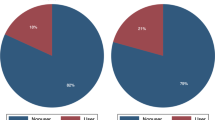Abstract
A number of different causal mechanisms have been proposed to explain the onset of fertility declines in populations with previously uncontrolled fertility, but they have never been adequately tested. The present study identifies and tests five antecedents to family limitation practices in a sample of 755 currently married couples resident in rural Northern Thailand. The loglinear multiple regression models estimated indicate that couples in more developed districts, more modern couples, couples in which wives have more equal roles, couples believing that intergenerational wealth transfers favor children rather than their parents, and more wealthy couples, were all significantly more likely to be early adopters of contraception. Local development levels appeared to have the greatest net effects on the timing of adoption of fertility control. In addition, couples in areas where contraceptive services were more readily available were also significantly more likely to be contraceptive innovators, net of these five variables.
Similar content being viewed by others
References
Baltes, P. B., S. W. Cornelius, and J. R. Nesselroade. 1979. Cohort Effects in Developmental Psychology. Pp, 61-87 in Longitudinal Research in the Study of Behavior and Development. New York: Academic.
Birdsall, N. 1977. Analytical Approaches to the Relationship of Population Growth and Development. Population and Development Review 3:63–102.
Bogue, D. J. 1976.A Cross-Cultural IEC Interview for Measuring the Progress of Family Planning and the Communication Obstacles to the Adoption of Family Planning Within Any Population. Unpublished manuscript, Community and Family Study Center, University of Chicago.
Bogue, D. J. and E. J. Bogue. 1970. Techniques of Pregnancy History Analysis. University of Chicago: Community and Family Study Center.
Caldwell, J. C. 1976. Toward a Restatement of Demographic Transition Theory. Population and Development Review 2:321–66.
— 1978. A Theory of Fertility: From High Plateau to Destabilization. Population and Development Review 4:553–77.
— 1980. Mass Education as a Determinant of the Timing of Fertility Decline. Population and Development Review 6:225–55.
Easterlin, R. A. 1978. The Economics and Sociology of Fertility: A Synthesis. pp. 57–133 in Charles Tilly (ed.), Historical Studies of Changing Fertility. Princeton: Princeton University Press.
Fawcett, J. T. and M. H. Bomstein. 1973. Modernization, Individual Modernity, and Fertility. Pp. 106–31 in James T. Fawcett (ed.), Psychological Perspectives on Population. New York: Basic Books.
Freedman, R. 1979. Theories of Fertility Decline: A Reappraisal. Social Forces 58:1–17.
Goodman, L. A. 1971. The Analysis of Multidimensional Contingency Tables: Stepwise Procedures and Direct Estimation Methods for Building Models for Multiple Classifications. Technometrics 13:33–61.
— 1972. A Modified Multiple Regression Approach to the Analysis of Dichotomous Variables. American Sociological Review 37:28–46.
Hogan, D. P. 1978. An Evaluation of the Demographic Impact of the National Family Planning Program of Thailand. Paper presented at the annual meetings of the American Sociological Association, San Francisco (August).
Khoo, Siew-Ean. 1979. Measuring the Thai Family Planning Program’s Impact on Fertility Rates: A Comparison of Computer Models. Studies in Family Planning 10:137–45.
Knodel, J. 1977. Family Limitation and the Fertility Transition: Evidence from the Age Patterns 614 of Fertility in Europe and Asia. Population Studies XXXI:219–249.
Knodel, John and Nibhon Debavalya. 1978. Thailand’s Reproductive Revolution. International Family Planning Perspectives and Digest 4:34–49.
Knodel, John, Nibhon Debavalya, and Peerasit Kamnuansilpa. 1980. Thailand’s Continuing Reproductive Revolution. International Family Planning Perspectives and Digest 6:84–97.
Mauldin, W. P. and B. Berelson. 1978. Conditions of Fertility Decline in Developing Countries, 1965-75. Studies in Family Planning 9:90–147.
National Research Council. 1980. Fertility and Mortality Changes in Thailand, 1950–1975. Committee on Population and Demography, Report No. 2. Washington, D.C.: National Academy of Sciences.
Oppong, C. and E. Haavio-Mannila. 1979. Women, Population, and Development. Pp. 440–85 in Philip M. Hauser (ed.), World Population and Development: Challenges and Prospects. Syracuse: Syracuse University Press.
Pardthaisong, Tieng. 1977.Analysis of Recent Fertility Decline in the Chiang Mai Region of Thailand. Unpublished paper, Chiang Mai University.
Pardthaisong, Tieng. 1978. The Recent Fertility Decline in the Chiang Mai Area of Thailand. Papers of the EastWest Population Institute, No. 47 (February).
Ryder, N. B. 1965. The Cohort as a Concept in the Study of Social Change. American Sociological Review 30:843–861.
Shevasunt, S. and D. P. Hogan. 1979. Fertility and Family Planning in Rural Northern Thailand, 1976-1977. Chicago: University of Chicago Community and Family Study Center.
Shevasunt, Somphong, Dennis P. Hogan, and Kwanchai Thaithong. 1978. Fertility and Family Plannig in Rural Northern Thailand. Studies in Family Planning 9:212–21.
Teachman, J., D. J. Bogue, J. Londono, and D. Hogan. 1979. The Impact of Family Planning Programs on Fertility Rates. Chicago: University of Chicago Community and Family Study Center.
Tsui, A. O. and D. J. Bogue. 1978. DecliningWorld Fertility: Trends, Causes, Implications. Population Bulletin, Vol. 33, No. 4. Washington, D.C.: Population Reference Bureau, Inc.
United Nations Department of Economic and Social Affairs. 1973. The Determinants and Consequences of Population Trends, Population Studies, No. 50, Vol. I. New York: United Nations.
Van de Walle, E. and J. Knodel. 1980. Europe’s Fertility Transition: New Evidence and Lessons for Today’s Developing World. Population Bulletin, Vol. 34, No. 6. Washington, D.C.: Population Reference Bureau, Inc.
Author information
Authors and Affiliations
Rights and permissions
About this article
Cite this article
Hogan, D.P., Frenzen, P.D. Antecedents to contraceptive innovation: Evidence from rural Northern Thailand. Demography 18, 597–614 (1981). https://doi.org/10.2307/2060949
Issue Date:
DOI: https://doi.org/10.2307/2060949




